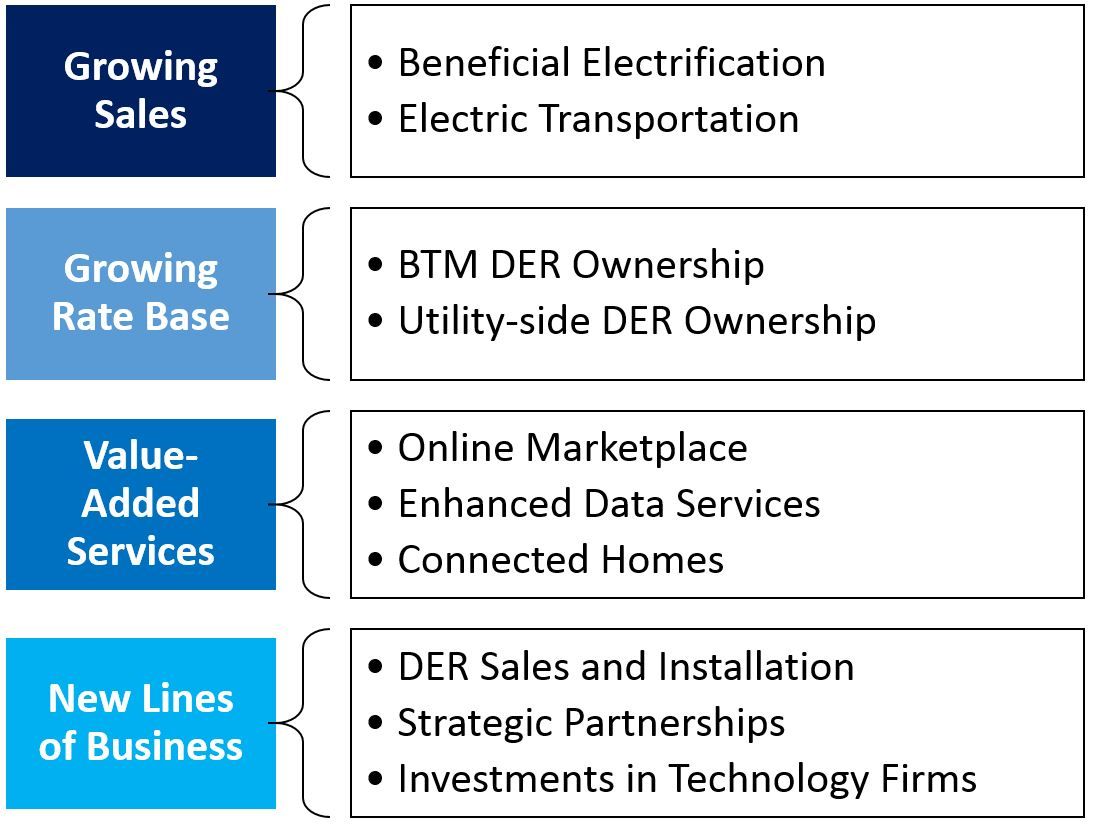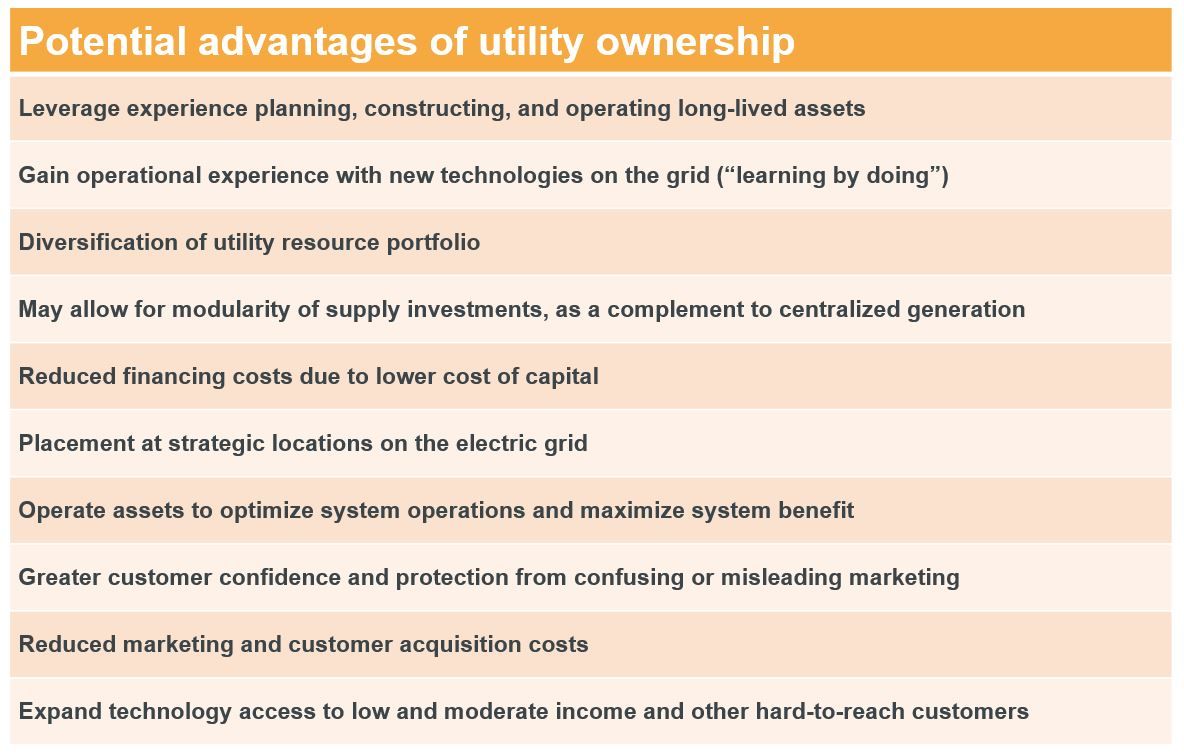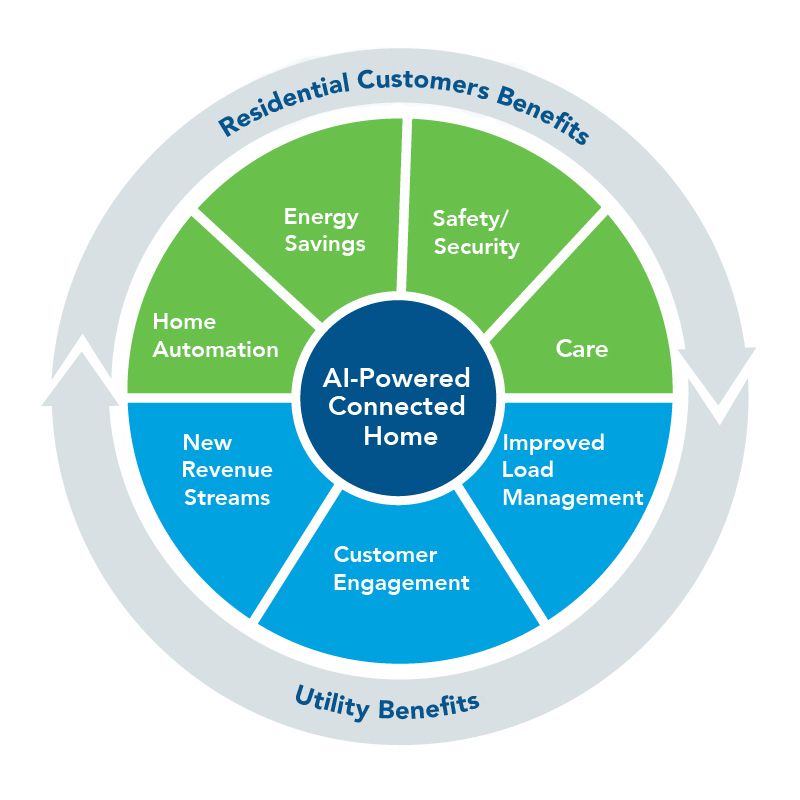
Revenue growth opportunities for utilities
This article was updated on June 1, 2020
The utility business is changing, which means new products and services to keep customers happy...and revenue growing.
Today’s customers are increasingly interested in new energy choices that give them greater control, comfort, and convenience. As customer expectations rise, the one-size-fits-all service model of the past is shifting toward greater segmentation, customization, and innovation—with an expanded portfolio of customer programs, products, and services smartly targeted to the customers most likely to benefit.
For the utilities sector, value creation is increasingly driven by anticipating and satisfying these changing customer needs and enhancing the customer experience. Utilities can create new sources of revenue that hedge against declining sales growth and other competitive pressures, as well as improve customer satisfaction. Increasingly, as electric utilities modernize and add capabilities to the grid, new program options are doing double or triple duty—providing benefits to customers, serving as a grid resource, and potentially growing earnings through capital investment or regulatory incentives.
The best fit for a given utility business depends on several factors, including (but not limited to) the utility’s strategic priorities, regulatory environment, customer base, and existing capabilities. ICF experts have identified four paths for growing revenue through the provision of new customer offerings, providing illustrative examples as well. The framework discussed here helps clearly define strategic objectives, identify options that align with those objectives, and screen and prioritize opportunities based on the metrics that matter most.
Satisfying today’s energy consumer
Forward-thinking companies from the tech sphere, like Amazon and Apple, are changing what customers expect from their service providers. Customers want a menu of options that they can customize to meet their energy preferences, whether those are focused on controlling energy costs, improving the comfort of their homes and businesses, promoting environmental stewardship, or other interests.
In a world of growing options and market actors, there is the potential for heightened customer confusion and inertia as decisions become more complex and require greater time and resources to vet. Many customers will be left asking, “Who can I trust?”
Utilities have the opportunity to be a beacon in a crowded marketplace and strengthen customer loyalty. As that trusted advisor, utilities are well-positioned to be the preferred provider of new products and services—leading to new revenue and earnings opportunities, as well as continued relevance in a rapidly-changing market.
Charting paths forward
We’ve outlined four paths that lead to new growth opportunities, each with risks and rewards. Some are a natural extension of the current utility business model, while others represent a greater degree of change.
Figure 1: The four pathways and opportunities for utility growth

The relative revenue potential of these opportunities depends on factors like market demographics, regulatory treatment, and capital availability. At a high level, the best options in the short-term are scalable programs that increase revenue without requiring major capital outlays, such as growing sales through beneficial electrification programs and creating new revenue streams through value-added services that expand on current capabilities, like online marketplaces and connected home programs.
Investing in customer-facing assets and launching new lines of businesses typically come with greater regulatory and operational hurdles. But they can bring significant benefits when properly executed, including creating a broader utility business model.
The competition for customers’ energy dollars is heating up—utilities around the country are exploring new ways to engage customers by offering new products and services.
 Growing sales
Growing sales
Advancements in electric end-use technologies have created opportunities for utilities to increase sales in all market sectors. In transportation, for example, battery electric vehicles (EVs) are a viable and sustainable alternative for consumers and businesses alike. Likewise, new electric technologies such as cold-climate heat pumps, advanced process heating, and indoor farming, are expanding the market potential for electricity consumption in buildings, industry, and agriculture.
Utilities are developing a new class of programs, termed “beneficial electrification,” to capture this market by promoting the use of electrically-powered equipment over fossil-fueled equipment across a variety of applications. Beneficial electrification programs create new demand for electricity while also providing benefits to customers and to the environment. For many utilities, the new load generated by beneficial electrification utilizes excess capacity and increases the sales base over which fixed costs are spread. Beyond the obvious benefits of increased load, utilities may also benefit from treating these new end-uses as manageable or flexible load. Program participants benefit from increased productivity, reduced energy costs, and cleaner work environments. Environmental benefits are realized when the electric equipment has a lower carbon footprint than the fossil fuel equipment it is replacing. And, as the power supply shifts to low- and no-carbon resources, the environmental benefits of electrification increase.
Utility electrification programs use a variety of approaches to promote the use of efficient electric technologies where they provide economic and environmental benefits. For example, Salt River Project’s program uses a combination of downstream and upstream incentives on electric equipment and charging infrastructure. CenterPoint Energy’s electrification program, implemented by ICF since 2008, is primarily driven through forklift dealer engagement and training. Other programs provide special accommodations for service extensions such as CIAC (contribution in aid of construction) relief. Still others provide non-cash assistance in the form of fleet advisory services. In order to accommodate large or complex electrification projects, utilities may also offer custom incentives, calculated based on the value of the projected load. For example, Entergy provides onsite consultations designed to identify electrification projects that may qualify for custom financial incentives.
Electric on-road transportation also represents a significant potential source of new electricity sales in the long term. A typical light-duty EV, at 12,000 miles traveled per year, uses approximately 3,000 to 4,000 kWh/year, depending on the size of the vehicle. Medium- and heavy-duty fleet vehicles now coming on the market represent larger loads. School buses and transit buses, for example, are both seen as good candidates for electrification.
Utilities are largely supporting electric transportation by educating consumers about vehicle and charging options and introducing new tariffs that make charging affordable. A key factor limiting the growth of EV ownership is the lack of publicly accessible charging infrastructure, leading utilities to invest in increased availability of charging equipment at workplaces, retail centers, and public venues.
Electric transportation program models are still emerging and include rebates for charging equipment and installation, utility-owned charging, fleet EV charging incentives, and incentives for managed charging. Commercial and municipal vehicle fleets are an emerging area of interest for utility program developers because they potentially represent a highly manageable load. Some utilities, for example, are exploring the possibility of leveraging a fleet of connected school bus batteries as a grid asset.
The regulatory issues to consider in implementing beneficial electrification programs include promotional practice rules and cost recovery of program expenses. For example, in many states regulated utilities are not generally permitted to recover costs to advertise or promote electric use, particularly in cases of fuel switching. We are, however, beginning to see a shift toward allowing beneficial fuel switching in some jurisdictions such as California and New York, which will allow utilities to pay rebates for heat pumps replacing fossil fuel heating systems, and Minnesota, which is considering legislation that would add beneficial electrification to the state’s Conservation Improvement Program.
Utilities in other progressive jurisdictions are recovering costs for promotion of electrotechnologies where they are shown to provide environmental benefits and meet cost-effectiveness tests, like the rate impact measure test. Where a state’s Demand-Side Management (DSM) rules define energy efficiency and conservation in a way that is incompatible with electrification, electrification programs are typically paid out of operating expense budgets and can be funded below the line.
 Growing rate base
Growing rate base
One of the primary ways utilities create shareholder value is by investing in assets and increasing the rate base on which they earn their authorized return. New customer offerings that allow for utility ownership of program assets, such as owning a community solar array, or policies that let utilities treat energy efficiency expenses as capital, provide a chance to grow rate base and increase earnings. This is likely a greater opportunity for vertically integrated utilities, as they typically face fewer restrictions on asset ownership compared to utilities in states with retail competition, where there may be rules prohibiting utility ownership of generation assets and/or prohibiting utility ownership of assets behind the customer’s meter.
Where not prohibited, the potential advantages of broadening utility asset bases to include distributed generation and other distributed energy resources (DER) must be balanced against the potential for anti-competitive behavior that will limit market growth, slow innovation, and disadvantage other competitors.
Local market conditions impact the potential risk of competitive issues, with the greatest concern present in areas with existing broad and robust competitive markets in which the utility would directly compete. Similarly, policy considerations may come into play. For example, states with aggressive renewable energy goals or other policy mandates may leave all options for increasing renewable energy adoption on the table, including utility ownership where it serves the public interest.
Some states with retail competition are exploring exemptions to this policy to meet specific needs, such as supporting grid reliability and resiliency or filling gaps in the market, as well as promoting the expansion of particular technologies like storage. Other considerations are cost-competitiveness with third parties and the willingness of utilities and regulators to accept the risk of cost overruns and market and technology change.
Utility-owned assets can be located in front of the customer meter—on the utility’s side—or behind the meter (BTM). Some examples of asset-based technologies that can be considered for utility ownership include rooftop and community solar, smart inverters, energy storage, microgrids, and combined heat and power (CHP).
An example of utility ownership of customer-sited equipment is onsite CHP systems. In many states, electric utilities can treat CHP investments as rate-based supply assets—the same as any other supply-side investment. Through ownership of a CHP asset, the utility earns on the invested capital and continues to serve the full customer electric load, without the loss of revenue that occurs when a customer invests in CHP.
In May 2019, the Michigan Public Service Commission approved rate recovery for a 34 MW CHP plant owned by DTE Electric at Ford Motor Company’s Research and Engineering Center in Dearborn. The CHP system will provide steam for the campus and produce electricity to be sold on the power grid, while offering tangible benefits to DTE and its customer base. The investment allows DTE to avoid the need to spend an estimated $5 million to upgrade aging distribution infrastructure and frees up capacity at another substation, which can be used by other customers seeking to install DERs. In their testimony, DTE estimated the project saves $102 million that Michigan customers would otherwise pay to make up for the utility’s lost margins if Ford pursued CHP behind-the-meter instead of partnering with DTE on a front-of-the-meter solution.

Investing in assets that enable new options can benefit utilities and customers, including currently underserved populations. Third parties reap rewards as well when the utility serves as a market catalyst or relies on third-party installers to implement the program.
While there are regulatory and policy hurdles, there are circumstances that may support utility ownership, such as:
- limited- to no-market development.
- low consumer awareness and acceptance.
- opportunity to target underserved populations.
- access to lower-cost capital.
- ability to leverage existing utility property and infrastructure.
- ambitious energy policy goals.
The increasing interest in non-wires alternatives (NWA) may seem counter to this growth strategy. After all, NWA are intended to avoid or defer traditional capital investments—typically through targeted utility programs or procurement of third-party solutions. While NWA are suitable replacements for only a small subset of utility investments, this growing trend means that more and more utility investments will be challenged based on whether DER, particularly behind-the-meter DER, could meet the identified system need.
Under traditional regulation, NWA represent a threat to utility earnings because they reduce the volume of potential capital investments. However, many states have taken steps to align utility financial interests with energy efficiency, and the same types of regulatory alignments can be applied to NWA.
For example, under the regulatory framework put in place in New York, the earnings on an NWA project can be higher than on the traditional investment. Pursuant to Commission Order, Con Edison can recover and earn its allowed rate of return on the full NWA project costs. A shared savings incentive based on the net benefits of the NWA relative to the traditional solution provides an additional source of earnings. Through these steps, Con Edison is encouraged to pursue NWA for all possible capital investments.
 Value-added services
Value-added services
Value-added services are specialized services provided to customers and/or third parties in exchange for a fee, revenue sharing mechanism, or other financial benefits. For the purposes of this article, the emphasis is on services that work as an extension of a utility’s regulated operations and are provided through the regulated business (though offering the service through a separate, unregulated entity may be preferred depending on the utility’s particular situation and priorities).
Often, value-added services leverage existing marketing channels and related IT systems, and back office support to effectively target customers and streamline the utility’s service offering. These same resources can be used to provide value-added services to third parties, who can leverage this data to inform their business strategy and reduce customer acquisition costs.
In addition to taking advantage of their data, utilities can employ their experience designing and installing electric infrastructure to provide turnkey projects, such as the installation of CHP or microgrids at customer sites to improve reliability. Other examples of utility product and service strategies are online marketplaces and connected or “smart home” offerings.
Online marketplace
With 10% of all retail sales occurring online and expected to grow at 15% each year, the online market can’t be ignored by utilities seeking to expand revenue generation avenues.
As customers feel more comfortable navigating the digital world to make purchases, utilities can step in to provide a trusted platform for energy efficient home goods. These spaces offer an opportunity to add to revenue and provide another touchpoint to build engagement, satisfaction, and trust along customers’ energy journey.
Most utility marketplaces had their start in lighting catalogs (think specialty light bulbs) and online fulfillment. Long-term, we envision the market expanding to play a role as a centralized hub that serves a wide variety of product and service needs for customers, which can also increase the revenue generated through the marketplace.
This future will increasingly provide DER like distributed solar and storage, and energy management platforms and controls to customers. DER provide a plethora of opportunities to give customers the products they want and the opportunity to serve as grid resources.
Smart homes
The growth of the smart home market allows utilities to generate new revenue streams by offering customers home automation and related services.
As technology improvements such as artificial intelligence (AI) mature, new services that will enhance the quality of life through smart homes enable utilities to redefine their relationships with customers. These can be natural extensions from current utility offerings of energy and efficiency services into other household services under a trusted name.
As the internet of things (IoT) continues to grow, more services that tap into the energy infrastructure of households will spring up. These can include AI programs to monitor and learn occupants’ patterns to automate functions such as heating water only when needed (e.g., for a hot shower in the morning and for cooking in the evening), or to turn the lights off when everyone is out of the house.
Smart home services are expanding into new areas such as home security monitoring and home care services for a rapidly aging population. These systems represent a frontier for services wired into the energy infrastructure of the home, which utilities can employ for better customer data, a better-managed grid, and stronger customer relationships.
Figure 2. Current value-added services for households and utilities through connected homes

These value-added services through smart homes will also provide the ability to improve demand-response and other programs through a more interactive relationship with customers and a greater ability to control and automate the energy consuming devices in their homes. What started with smart thermostats will eventually evolve into bidirectional communications between smart home platforms and distributed energy resource management systems (DERMS).
Grid managers will communicate its load and demand needs through DERMS, and hear back from smart homes on the availability of specific appliances to “meet the call.” Smart homes have the ability to identify different occupancy states (i.e., away, home awake, home asleep) which allow for more intelligent control of devices with minimum disruption to customers. The end result will be a distributed grid where the demand follows supply, creating harmony between the grid and lives of homeowners.
At the center of these services will exist the utility who can be seen as a manager of multiple home services within one entity. The data gleaned from a connected grid will allow utilities to promote energy savings and other services at the most opportune time for customers and their grid.
 New lines of business
New lines of business
Some utilities are exploring new lines of business such as solar and DER installations, appliance servicing and repair, home warranty services, vegetation management, real estate services, and outdoor/security lighting. These services are typically offered through an unregulated affiliate, subject to code of conduct rules to ensure a level playing field.
As an example, Duke Energy provides home protection plans as market-based, unregulated offerings, which include (but are not limited to) home wiring repair, surge protection plans, and HVAC repair. Other examples of utilities offering competitive products and services through unregulated affiliates include Exelon (Constellation Energy), Edison International/Southern California Edison (Edison Energy and SoCore Energy, among others), and Southern Company (Southern Power).
Several utilities are currently investing in technology companies or forming strategic partnerships with third parties. For example, American Electric Power (AEP) invested $5 million in the energy storage software provider Greensmith and is partnering with them on an energy storage system in West Virginia. Ameren, National Grid, Southern Company, Xcel Energy, and other utilities have teamed with Energy Impact Partners—a venture capital firm—to invest in innovative energy technology companies. Aside from investment returns, partner utilities can benefit through enhanced visibility and understanding of the emerging technology landscape, on top of identifying potential partnership or pilot opportunities.
As mentioned above, code of conduct issues are typically front and center when proposing competitive services. These rules are intended to prevent utilities from using their position as a monopoly energy provider to create an unfair competitive advantage, and often involve—at a minimum—creating a firewall to prevent information sharing between regulated and unregulated entities. Additionally, it is often necessary to demonstrate that resources paid for by customers of the regulated entity are not used to support the unregulated business.
Navigating the universe of potential product and service offerings is challenging—our approach guides utilities toward the highest-potential, best-fit options.
Ready…set…prioritize
The best path for a specific utility depends on several factors. Strategic priorities, risk tolerance, regulatory environment, current resources and capabilities, and service territory characteristics all play a role, among others.
Finding and selecting the best path or paths starts with a framework for evaluating and ranking the options and identifying potential risks. Utilities must also produce realistic projections of expected earnings.
The utility industry is continuing its move away from a commodity-based business toward a customer-centric model that seeks to uncover new sources of value for customers. For many utilities, this requires a reassertion and strengthening of their role as a trusted energy provider and enabler of choice. By aligning customer value with utility value through the offering of new products and services, utilities can establish a sustainable framework that helps them adapt to industry trends and capture new strategic growth opportunities.